A wave of new subscribers signed up thanks to recommending my newsletter in her widely read . I’m glad you’re here! In case you’d like a starting point for reading some archived content, the second half of this post lists a sample of top posts from 2023.
A week from now (Wednesday, January 17, at 5 p.m. Mountain), I host the monthly online chat for paid subscribers. I’m excited to welcome a special guest and friend who’s a highly accomplished ultrarunner at 54 and who recently went through open-heart surgery. She’ll talk to us about her experience and answer questions about ultra training and her prognosis for getting back to the trails. If you’d like to be a part of the conversation, please consider upgrading your subscription to the supporter level ($6/month or $60/year for access to bonus posts and the monthly Zoom).
This week’s issue features two stories plus some recommendations at the end. In the comments below, please feel free to introduce yourself and say a bit about your background and goals (running-related or other).
You get used to it
We’re in the crazy-cold months here, which drives me to run indoors on a treadmill more frequently. But I ran outside for five hours on slow, snowy trails and roads last Saturday, and another hour-plus Monday, with temps in the mid-teens. When the sun ducked behind a cloud and the wind blew, it felt like single-digit-level cold.
My buff freezes in front of my mouth while my nose numbs, but my chest works like a furnace that sends warmth down the limbs. Sometimes I take off my gloves because the nippy cold feels good on my fingertips. How can this be? I used to hate the cold! In California, I could barely handle feeling chilly when temps dropped to the mere 40s.
We’re adaptable, that’s how. If I can get used to this, anyone can. It just takes the right clothing layers, a willingness to plunge into the discomfort, and a gradual buildup of tolerance. Running in extreme environments has a lot to do with getting comfortable with the uncomfortable.
I’m thinking of adaptability—counting on it—as I look ahead to summer training for the Grand to Grand Ultra, where temperatures on shadeless desert plateaus reach triple digits. I’ll run with the added challenge of a pack that weighs about 20 pounds and holds all my food and sleeping gear for the week. The sun will crisp the backs of hands and calves, and if a breeze breaks the suffocating still air, it will feel as if a hairdryer set on high is blowing on the face.
I’ve also been thinking more deeply about why I’m drawn to return for a fourth time to this event. The answer comes across in a short essay I rediscovered. I wrote it nine years ago, after the event’s 2014 edition. I decided to share it here because I hope it might intrigue you to consider this adventure or something like it. The race takes place in the final week of September, and nine months really is enough time to train and adapt.
Here’s the story:
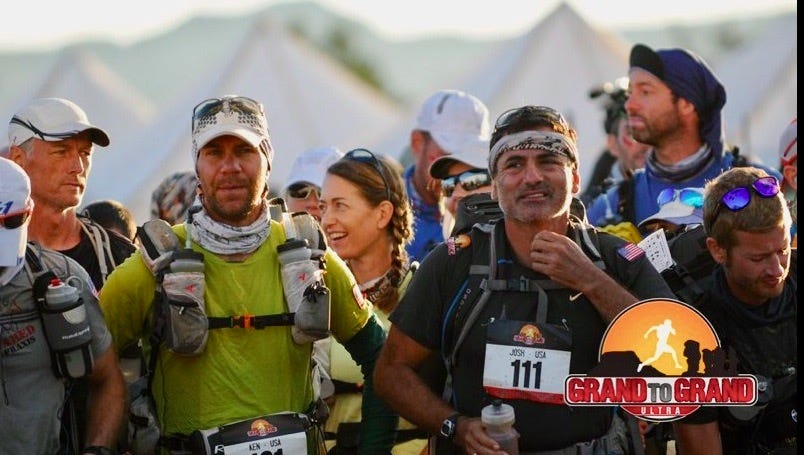
Wearing raggedy gray underwear and a black sports bra stained with dried sweat, I step out of a canvas tent in the high desert backcountry of Southern Utah. To cool down in the afternoon heat, I squirt a small amount of rationed drinking water onto the fabric buff around my neck, which I’ve been using all week to wipe my nose. The smell of campfire smoke lingers in my hair and blends with the rank odor from my upper body.
Around me, skinny, scratched-up, half-dressed runners step gingerly on bandaged feet through a campsite where briers sprout burrs and anthills spill red ants. On some of the runners’ backs and shoulders, medical tape covers welts of chafed skin caused by the rubbing of packs.
Some 100 people and I are into Day 5 of a seven-day odyssey known as the Grand to Grand Ultra, a 170-mile self-supported stage race that involves running cross-country through sandy, technical terrain and severe weather while carrying our food and gear on our backs and camping in communal tents overnight.
Most tend to think of this race as an athletic event that presents an extreme test of endurance, and it certainly is that. But I also think of—and value—it as a lifestyle challenge that provides a taste of a wild, tribal, and ascetic way of life that has mostly disappeared from our 21st-century developed world.
A thread of conversation floats out of a canvas tent where two hungry runners bargain over calories. “I’ll trade you two oatmeals for 300 calories of something salty,” says one. “I’m dying for salt!”
A shirtless British runner nearby, who’s wearing slippers he made at camp by cutting pieces of cardboard and attaching them to his feet with hair ties, produces a thunderous fart. Another Brit, standing next to him, nods approvingly.
“Better out than in, mate,” says the friend.
I can’t help but laugh and tweak the Talking Heads lyric in my head, This is not my beautiful house / This is not my beautiful life!
In my regular life, I belong to a demographic where appearances matter. When women in my neighborhood get dirty, they’re usually wearing garden gloves. They exercise at a barre or spin studio, and they pay a dermatologist big bucks for shots to melt away the lines between their eyebrows. Adventure might be chaperoning a field trip—something I do, too.
I have a mild side that appreciates the community in which I live and raise my two teens, yet the wild side yearns to break out of the bubble. So I hit the trails and run hard. I never want to lose touch with the natural world or take creature comforts for granted.
But a daily trail run can only do so much to build character and renew gratitude. That’s why I believe in endeavoring to go on a journey to somewhere far beyond my comfort zone, for at least a week each year.
In the first five stages, we run back-to-back marathons with a 53-miler on Day 3, scrambling up the rocky faces of vermillion cliffs and slippery sides of pink-hued sand dunes. Then we unite at camp to care for our feet, rehydrate our paltry dried meals-in-a-bag, and revel in each others’ company.
On the next-to-last morning, a maniacal guy exhorts his tent mates to run one more stage on slow, tired legs by screeching, “It’s show time, bitches! We’re gonna rock these 26 miles!”
Later on the trail, slogging through soft footing, one runner says to another, “I don’t know what I’m going to do next week, walking on a hard surface. I’m quite going to miss this sand.”
“I’m going to miss eating out of a bag,” replies his friend.
I’m going to miss these people and the environment. I especially will miss this stripped-down, off-the-grid life where my only job is to run from one point to another and survive along the way.
And I’ll even miss the smelly, earthy dirtiness. I don’t want it all to wash away.
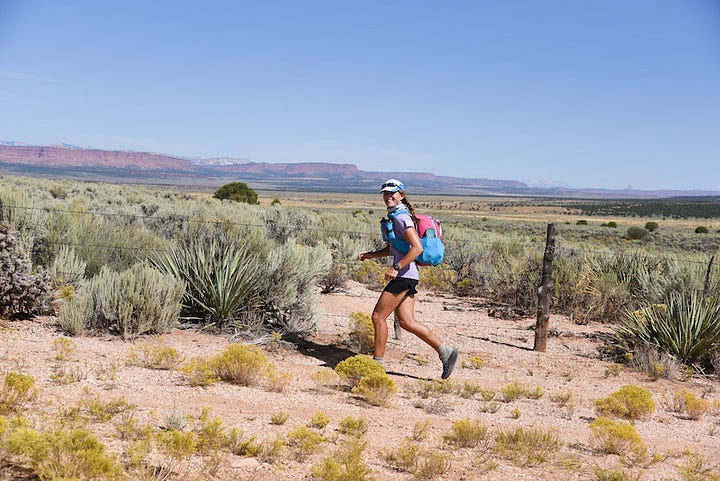
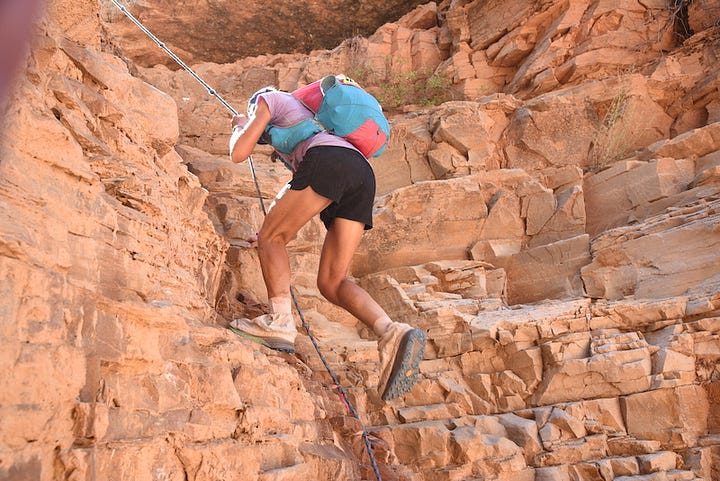
If you’re interested in this event or stage racing in general, hit me up with your questions. Also, check out the website and listen to this podcast for advice on how to train.
Brace yourself for a 180. I’m shifting here from extreme running in a remote environment to everyday running in an urban one.
The Substack platform hosts numerous runner-writers who write about different aspects of the sport and its culture. One I admire is
and his newsletter . Raziq, who goes by Raz, writes about other interesting runners more than about himself, and he contacted me to write about my running and newsletter (thank you!). I took the opportunity to find out about him.Find your sweet spot
Raz, who’s 40, lives and runs around the Glendale area of Los Angeles, dodging cars and pausing at busy intersections. He’d like to run trails more frequently but doesn’t want to spend the half hour or more it takes to drive to a trailhead. He devotes most of his time to working as a copywriter and being a dad to two young boys.
A former music journalist from London, he ran track as a student and took up running again at 25 to counteract the less-healthy lifestyle of staying out late listening to bands. “I started running to get a bit of peace and quiet,” he told me. “My days were 100 percent filled with music, listening to music on the stereo and listening to bands play. I didn’t run with music and still don’t. I started running for my quiet time, like a meditative practice.”
He started his newsletter to tell stories about interesting runners—many of them activists in one way or another—and thereby promote inclusive running as well as satisfy his journalistic yearnings. He calls it “Running Sucks” to highlight the challenge of running and to make it “suck less.”
His profile subjects have included a large Black man who started the Slow AF Run Club, a breast cancer survivor who runs topless to reduce the stigma of a double mastectomy, and the founder of a running club for homeless runners.
It makes sense that Raz focuses on a lot of diverse run clubs and their founders, rather than on the competitive aspect of the sport, because his proudest achievement as a runner is starting a run club in his neighborhood.
“I’ve never really cared about personal bests,” he says. “Will I run longer distances? Not really. I like 5 and 10Ks, and more than that, I like running between 45 to 75 minutes. That’s my sweet spot on either side of an hour.”
His perspective hit me like fresh air. I and others get caught up in striving to go farther and get faster. Marathons? They’re only impressive if you Boston-qualify. 100-milers? They’re ordinary now; 200s are the new thing. It’s kind of nuts, and it’s why people think we ultrarunners are nuts.
Talking to Raz reminded me that consistently running a few miles a few times a week is healthy and all you really need. You may read my newsletter and start picturing yourself pursuing adventurous ultra-distance mountain running, which is great—but also not necessary. If you’re running short distances around your neighborhood and feeling good because of it, then bravo! You’re healthier than most Americans because of it. If that’s your sweet spot, stick with it.
Check out Raz’s newsletter for more of that perspective.
A few recommendations
Billy Yang has another short doc out, called Like a Lead Balloon, about a midpack, middle-aged runner from an impoverished upbringing who takes on the challenge of the Leadville 100. It’s a moving introduction to running 100 miles and to Leadville. Billy is a friend and one of my favorite visual storytellers. Search his channel for lots of inspiring trail-running short films.
I listened to the latest installment of
’s podcast because it features Coree Woltering, who has achieved a lot of success along with heartbreaking DNFs during his time as a professional ultrarunner. Adam’s podcasts tend to be short and to the point, and this one is only 15 minutes. Coree doesn’t talk much about his running but rather about achieving sobriety. His story is a nice shot of motivation for those of us doing Dry January (I’ve gone nine nights straight abstaining so far). He makes the point that we runners often go “all in,” and it’s difficult to do anything moderately or halfway, to which I can relate. I’ve passed Coree on the trail at the High Lonesome 100 when he was nearly passing out from altitude illness, and I’ve seen him cry at the side of the Western States 100. He’s an intriguing and inspiring person; learn more through this profile and meanwhile, check out Adam’s Community Trail Running newsletter.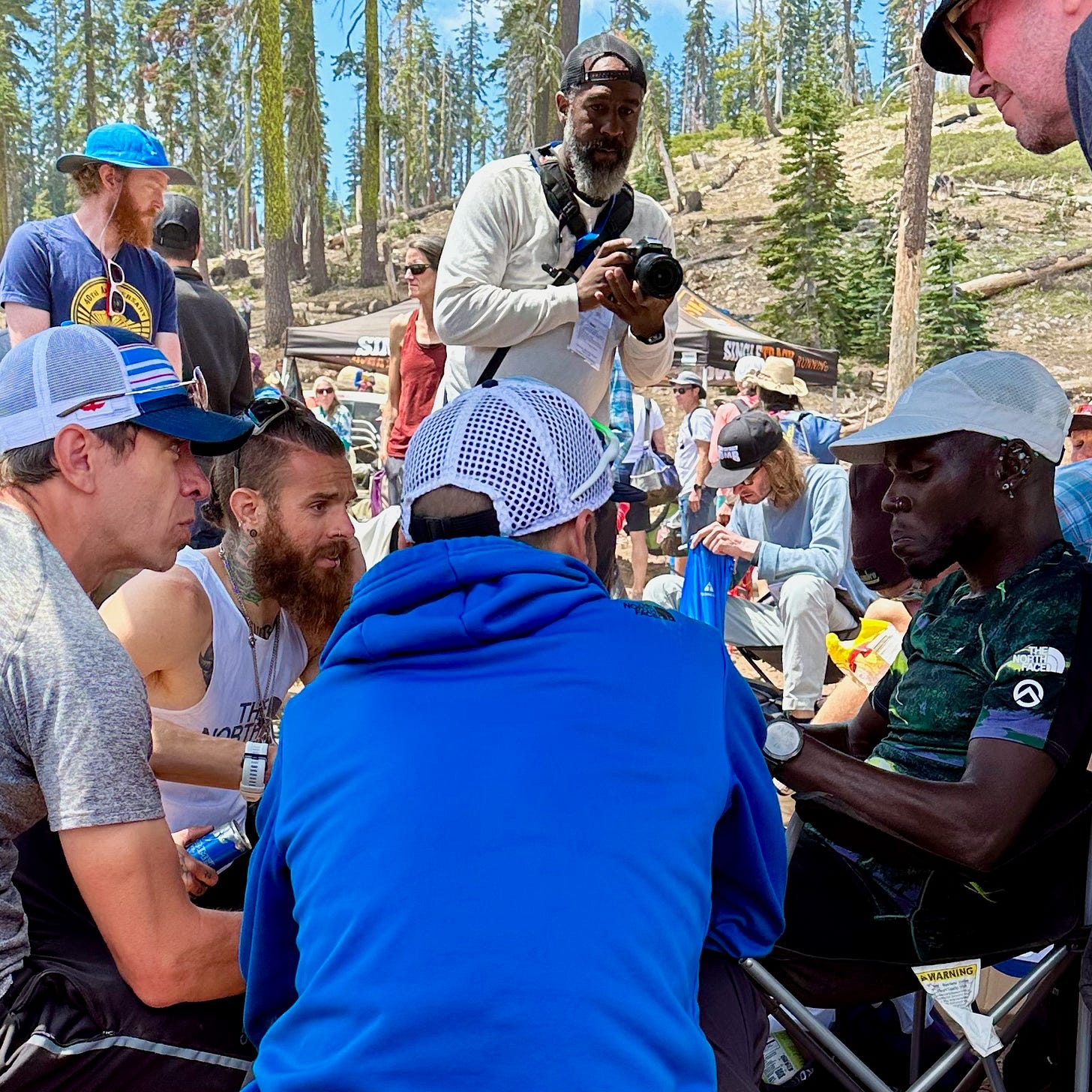
If my newsletter and its photos interest you in running some of the trails around Telluride, then I encourage you to consider one of these trail races put on by some local guys. They just updated their website with summer dates. Their Box Canyon 30K/10M in July is a great intro to sub-ultra high-altitude “running” (everyone downshifts to a lot of hiking in the thin air above tree line). The Deep Creek Half in late September runs right by my house. As I’ve written before, independent race directors who build community are the heart of this sport (and perhaps an endangered species given the UTMB-Ironman-ization) and deserve our support.
One of the coolest things in our region, the Ouray Ice Park, hosts the Ouray Ice Festival January 18 - 21. If you have any interest in ice climbing—or, if this is the first you’ve ever heard of it, and you’re intrigued—then try to make it out here for this event and its beginner-friendly clinics. I’ve dabbled in ice climbing for the past two winters and like it so much that I’m determined to return to the ice park for another go at it. For background:
Finally, I’ll end with something a 70-something woman told me yesterday. I skied with her and two other badass older ladies in their late 60s, all of them much better skiers than I. They wanted to go down a steep mogul run, and I didn’t want to be left behind.
“I can’t do big bumps,” I told her.
“You can’t do it if you don’t do it,” she shot back.
So I did it awkwardly, and didn’t enjoy it, but I was better at moguls by the end. Her words will stick with me this week and beyond.
If you’d like to support this newsletter but would rather not commit to a paid subscription, please consider a small donation to the virtual tip jar.








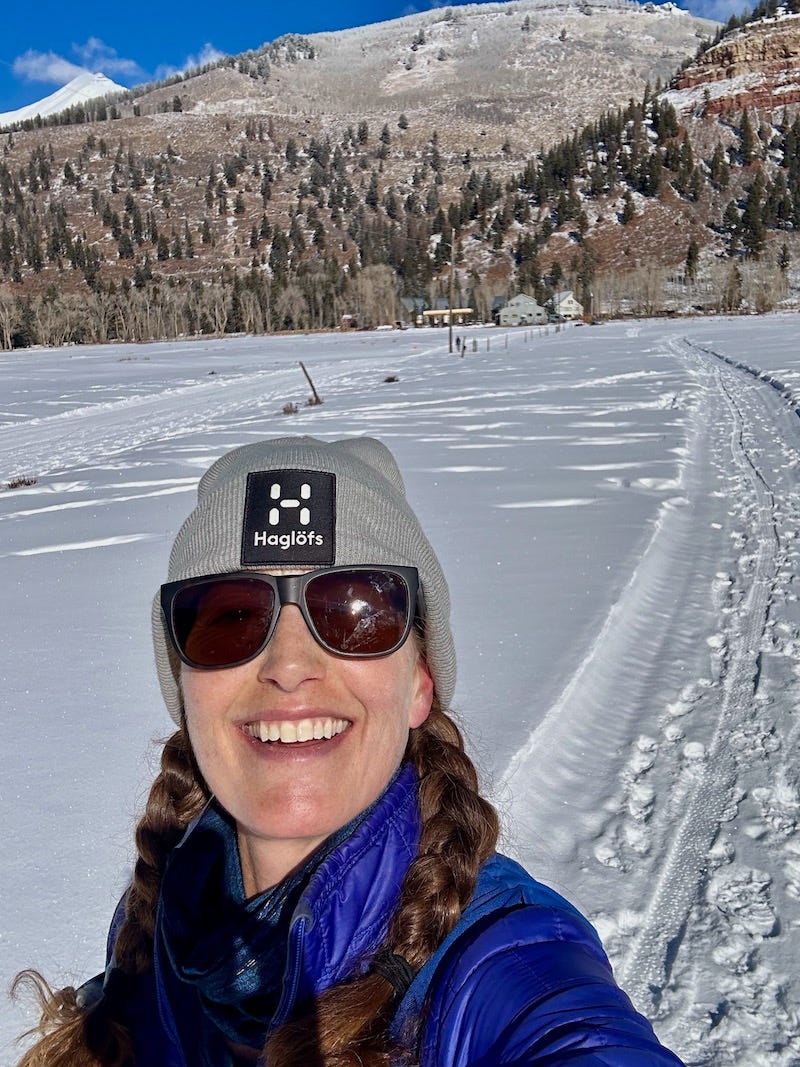
Thank you, Sarah! I'm about to go and claim the 300ft of vert in my neighborhood. Dodging Priuses and Teslas is the only cross training I need.
Thank you so much for your support and mentioning Community Trail Running Sarah! :) I was so grateful for Coree to come on the show and be so open about everything. I really enjoyed my conversation with him :)